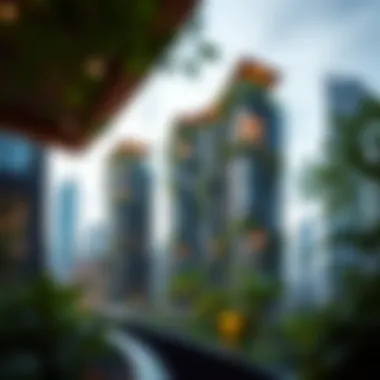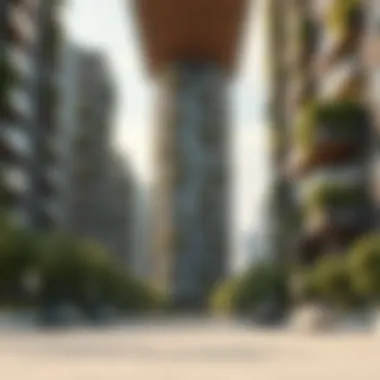Reimagining Urban Living with Garden Towers


Intro
In today’s urban landscape, the significance of green spaces cannot be overstated. With the relentless growth of cities, integrating nature within towering structures presents a unique solution to address various urban challenges. Garden towers, which uniquely blend architecture with greenery, are not only aesthetic marvels but also serve practical purposes in fostering sustainable urban development. As cities grapple with pollution, climate change, and social isolation, understanding the implications of garden towers is essential for investors, developers, and city planners alike.
With their ability to enhance biodiversity, improve air quality, and support community well-being, garden towers symbolize a thoughtful response to urban living in the 21st century. In this article, we will journey through the complexities surrounding garden towers, addressing their architectural designs, environmental contributions, and the evolving market dynamics that shape their future.
Market Trends and Insights
Current Market Conditions
As cities continue to expand vertically, the demand for innovative housing solutions has surged. The concept of garden towers is becoming more than just a trend; it’s increasingly seen as a necessity in urban planning. Cities like Singapore with the Parkroyal Collection Pickering have paved the way by showcasing how high-rise buildings adorned with extensive greenery can redefine residential living.
- Sustainability Focus: Investors are particularly drawn to projects that emphasize sustainability. Garden towers fit perfectly into this narrative, appealing to eco-conscious consumers.
- Regulatory Support: Many local governments offer incentives for developments that include green architecture. This includes tax breaks or grants that incentivize developers to integrate garden towers into their projects.
Future Predictions and Projections
The future of urban landscapes appears to be rooted in greener designs. As climate concerns continue to rise, garden towers are positioned to play a pivotal role in city planning:
- Growing Popularity: Expect to see a steady rise in the construction of garden towers over the next decade, as more cities adopt stricter environmental regulations.
- Investment Growth: Analysts predict a significant uptick in investment opportunities in neighborhoods that embrace garden tower development due to the potential for increased property values.
"The integration of nature within urban architecture is no longer a novelty, but a blueprint for the cities of tomorrow."
With clarity on market conditions, the next step is understanding the investment opportunities that garden towers present. By capitalizing on this trend, savvy investors can create, support, and promote spaces that not only meet ecological requirements but also foster a sense of community and well-being.
Prelude to Garden Towers
Urban development is no longer solely about constructing buildings that scrape the sky. Garden towers emerge as a key player, blending living spaces with green areas, transforming the concrete jungle into a more breathable environment. The growing emergence of these structures is driven by the increasing need for sustainability, community interaction, and better quality of life in densely populated cities.
Understanding garden towers is essential for multiple stakeholders—investors, homebuyers, developers, and analysts. This contemporary architectural trend fosters not only aesthetic value but also numerous environmental and social benefits. One can’t ignore the allure of having a patch of greenery right outside your window—a luxury in a bustling city. Such spaces offer refuge, relaxation, and a sense of community in an often chaotic urban setting.
Definition and Historical Context
Garden towers can be defined as high-rise buildings that incorporate green spaces, both vertically and horizontally. They serve as a hybrid model, striking a balance between urban density and ecological harmony. Historically, concepts like the Hanging Gardens of Babylon were perhaps the earliest inspirations, showcasing the desire to intertwine nature with living environments. Nowadays, architects are taking cues from such ancient wonders while employing modern technology to make them a reality. This modern manifestation has emerged as a response to urban sprawl, limited land availability, and environmental degradation.
Evolution of Urban Architecture
The evolution of urban architecture is a tale of creativity meeting necessity. In the past, city landscapes were dominated by glass and steel, often devoid of green elements. As urban populations grew, so did environmental concerns. Movements advocating for sustainable architecture gained momentum, leading to the green building initiatives we see today.
In this context, garden towers represent a paradigm shift in how we perceive urban structures. By utilizing various types of plants—native species, edible plants, and ornamental trees—these towers can function as mini-ecosystems. At the same time, they offer benefits like natural insulation, rainwater drainage systems, and CO2 absorption, all of which contribute positively to urban life.
"Garden towers are a fundamental step to shaping our urban future, emphasizing that concrete and nature are not enemies, but partners."
This architectural evolution does not merely serve aesthetic purposes but also tackles pressing issues such as biodiversity loss and air quality deterioration. As cities grow upward, the gardens in these towers offer solutions that not only enhance the visual appeal but also nurture animal habitats, thereby bridging the gap between nature and urban living.
Architectural Design Principles
The architectural design principles behind garden towers play a crucial role in redefining urban landscapes. It’s like finding the perfect spice for a dish; the right design elements can elevate a structure from merely functional to a vital part of the ecosystem. Understanding these principles not only helps in the construction of eco-friendly structures but also fosters a closer relationship between urban dwellers and nature.
Integration of Green Spaces
Integrating green spaces into the overall design of garden towers is fundamental. It’s not just a matter of slapping a few plants on balconies and calling it a day. Thoughtful integration means considering how these green spaces can influence the well-being of inhabitants and the surrounding environment.
For instance, incorporating vertical gardens can significantly increase biodiversity in urban areas. Plants not only provide aesthetic value but also contribute to improved air quality and reduced urban heat. According to experts, urban green spaces can lower temperatures in their vicinity, thus combating the heat island effect.
- Benefits of green spaces:
- Enhanced biodiversity
- Improved air quality
- Increased resident well-being
Moreover, these green areas can serve as communal spaces, offering residents a chance to cultivate their food or relax amidst nature. When design incorporates these considerations, it enables a symbiotic relationship between architecture and the environment.
Utilization of Vertical Space
When living in a bustling metropolis, space is often at a premium. Utilizing vertical space effectively is where garden towers shine. Instead of sprawling horizontally, these structures soar upwards, making the most of limited land. By designing upwards, architects can carve out unique spaces for inhabitants without encroaching on valuable ground level areas.
Imagine towering structures surrounded by lush greenery—this not only provides habitats for birds and insects but also creates scenic views for residents. Additionally, residents benefit from the gardens in the sky, where they can escape the hustle and bustle of the city below. In essence, vertical space utilization is about creativity and innovation.


"When designed thoughtfully, vertical spaces can transform previously uninhabitable areas into lush green havens."
Sustainable Materials and Construction Techniques
Sustainable architecture is more than just a buzzword; it’s a necessity in today’s context. Using sustainable materials and construction techniques in garden towers speaks volumes about a project’s commitment to environmental responsibility. Materials like bamboo, reclaimed wood, and recycled metals not only reduce ecological footprints but often enhance the visual appeal of buildings.
Building techniques can also play a part in sustainability. For instance, green roofs not only insulate buildings but also provide vital spaces for plant life. Natural ventilation systems can reduce the reliance on artificial heating and cooling.
Here’s a quick rundown of some sustainable materials:
- Bamboo: Renowned for its strength and rapid growth rate.
- Reclaimed wood: The use of previously harvested wood helps reduce waste.
- Recycled metals: These offer durability while minimizing mining impacts.
In urban settings, the applications of these materials can lead to economic benefits as well, such as energy savings, lowered maintenance costs, and an increase in property values.
Each of these principles, when applied thoughtfully, plays a significant role in how garden towers can revolutionize urban living. With a fresh perspective on architectural design, urban developers can create spaces that are not just livable but thrive within their ecological context.
By embracing these principles, stakeholders can contribute to a greener, more sustainable future while enhancing the quality of life for urban residents.
Environmental Impact
The integration of garden towers into urban environments presents a myriad of environmental benefits, aligning with the modern push for sustainable development. As urban areas grow denser, the need for innovative solutions that address ecological concerns becomes paramount. This section takes a closer look at the significant elements of environmental impact that garden towers contribute to urban spaces, exploring their role in enhancing biodiversity, improving air quality, and mitigating the urban heat island effect.
Biodiversity Enhancement
Garden towers provide a habitat for various species, promoting biodiversity in urban settings where green space is often scarce. By incorporating various plants, trees, and even small animals, these structures can create mini-ecosystems that function as sanctuaries for local wildlife.
- Native Plant Species: Using native flora in these towers encourages local fauna, such as birds, bees, and butterflies, to thrive, which is crucial for maintaining ecological balance.
- Pollinator Habitats: The design can include vertical gardens that serve as corridors for pollinators, supporting their populations and thus facilitating successful plant reproduction.
- Community Involvement: Residents can partake in planting and maintaining these gardens, effectively blending urban living with nature.
"Biodiversity isn’t just a luxury; it’s essential for our survival. Garden towers are one way we can help preserve it in our concrete jungles."
Air Quality Improvement
The presence of vegetation in garden towers plays a pivotal role in enhancing urban air quality. Plants naturally filter pollutants and carbon dioxide, releasing oxygen, which is vital for healthy urban living.
- Reduction of CO2 Levels: Trees and plants absorb CO2, a major contributor to climate change, significantly lowering levels in densely populated areas.
- Removal of Pollutants: Foliage captures particulate matter from the air, reducing respiratory issues among city dwellers.
- Cooling Effects: Through a process called evapotranspiration, plants can help cool the air, leading to more comfortable living conditions.
Research indicates that cities with more greenery experience fewer cases of asthma and other respiratory conditions, marking garden towers as a critical player in public health initiatives.
Urban Heat Island Mitigation
Urban heat islands (UHIs) are a phenomenon where city areas become significantly warmer than their rural surroundings, primarily due to human activities. Garden towers can mitigate these effects, contributing to temperature regulation in urban landscapes.
- Heat Absorption and Release: The vegetation on these towers can absorb sunlight, mitigating heat absorption by concrete and asphalt, thus reducing overall surface temperatures.
- Improved Microclimates: By introducing green spaces at various heights, garden towers can create cooler microclimates that benefit both biodiversity and the urban population.
- Energy Efficiency: A reduction in urban temperatures leads to decreased energy consumption for cooling purposes, translating into lower energy costs for residents and businesses.
As zoning codes evolve and environmental awareness grows, understanding these impacts is crucial for investors, developers, and city planners alike. Garden towers not only beautify cityscapes but also play an indispensable role in fostering a healthier, more sustainable urban environment.
For further information on these topics, check out Wikipedia or Britannica.
Social Benefits of Garden Towers
The introduction of garden towers in urban settings has rekindled discussions about livability, community, and the well-being of city dwellers. Unlike conventional high-rise buildings, these structures are designed with nature in mind, offering plenty of opportunities for social benefits that can revitalize communities. They serve as more than just places to live; they are platforms for interaction, recreation, and mental health improvement. The importance of this topic cannot be overstated in a world where urbanization often leads to isolation and disconnection.
Promoting Community Interaction
Garden towers foster a sense of community through their design. By integrating common green spaces, such as gardens, terraces, and communal areas, the architecture encourages people to come together. When residents have access to inviting communal spaces, they are likely to engage with one another more frequently.
Imagine a scenario where families gather in a rooftop garden, tending to plants or sharing stories about the day. Such environments reduce barriers, allowing people from different walks of life to connect. This unifying aspect can transform a mere high-rise into a vibrant community hub. Not to mention, participation in gardening has been shown to break down social divides.
- Key aspects that drive interaction include:
- Shared gardening responsibilities
- Community events held in these spaces
- Socially-designed recreational areas
In this way, garden towers are not just vertical neighborhoods; they are environments designed to encourage friendships and collaboration among residents.
Enhancing Mental Well-being


The mental health benefits of living in a garden tower are significant. People thrive in environments connected with nature. Access to greenery has been shown to reduce stress levels, which is particularly crucial in the hustle and bustle of urban living. Whether it's the fresh air from the plants or the simple act of being outdoors, these green spaces contribute to a happier state of mind.
Research indicates that even a small amount of time spent in nature can lower anxiety and depression. The designs of garden towers often strategically incorporate elements like water features or tranquil spots for contemplation, adding to the mental rejuvenation experience for residents.
- Benefits include:
- Decreased feelings of isolation
- Improved mood and happiness
- Increased physical activity, thanks to outdoor spaces
Thus, garden towers can serve as sanctuaries amid the chaos of city life, promoting a healthier, more balanced lifestyle for their inhabitants.
Recreational Opportunities
Garden towers provide a unique playground for recreation, merging the elements of nature with leisure. These towers serve as multi-functional spaces where residents can engage in a variety of activities, from gardening clubs to yoga sessions or even art installations. The benefits of these recreational opportunities are manifold, enhancing not just the physical but also the social tapestry of urban life.
By providing personalized spaces for interaction, these towers can play host to everything from fitness classes to social gatherings.
- Examples of recreational methods include:
- Outdoor fitness activities: Including yoga and tai chi on green terraces
- Gardening workshops: Where people learn how to cultivate plants and edible gardens
- Social clubs: Providing an avenue for organized events that bring people together
Not only do these activities promote a healthier lifestyle, but they also encourage a shared sense of identity among residents, nurturing a vibrant community spirit that transcends individual floors and apartments.
Garden towers redefine living by offering a sanctuary that combines the benefits of community interaction, mental well-being, and recreational opportunities for all residents.
Case Studies
Examining real-world examples of garden towers helps ground the concept in tangible outcomes. These case studies highlight the successes, challenges, and lessons learned from integrating green architecture into existing urban frameworks. Through careful analysis, we can draw insights on how such structures not only change the skyline but also enrich the lives of residents. Understanding these examples is crucial for investors, developers, and city planners who wish to replicate these successes in their own projects.
Successful Examples Worldwide
Several notable garden tower projects around the globe illustrate the benefits and practicality of this approach:
- Bosco Verticale, Milan: This set of residential towers features over 9,000 trees and 20,000 plants, which contribute to significant biodiversity in the city. Each apartment balcony acts as a mini garden, yielding not just visual beauty but also improved air quality. The project has faced challenges in maintaining its greenery, but the overall success showcases how urban life can harmonize with nature.
- Green Sky Residence, Singapore: Nestled in a city known for its lush urban greenery, this building integrates vertical gardens on every floor. Residents enjoy the sustainability benefits, while the building offers enhanced cooling effects, reducing energy costs. The vibrant greenery also promotes social interaction among neighbors who share gardening tips and exchange produce.
- One Central Park, Sydney: This development features a green wall designed by renowned architect architect and plant artist Patrick Blanc. Spanning thousands of square meters, the green wall serves multiple purposes: noise reduction, temperature regulation, and beautification of the urban landscape. The project's success demonstrates the significant role that aesthetics play in enhancing urban living spaces.
These examples underline how garden towers can function as self-sustaining ecosystems in dense urban environments. They foster not only a sense of community but also ensure that flora and fauna can thrive amidst the concrete jungle. By focusing on such successful implementations, we can inspire more cities to adopt similar methodologies.
Innovative Designs in Dubai
Dubai is a renowned hub of modern architectural innovation, and its take on garden towers exemplifies the city’s commitment to sustainable living:
- The Marina 101 Building: Once completed, it will be among the tallest residential buildings globally but is designed with several green features throughout its structure. The integration of hanging gardens and balcony gardens showcases the commitment to bringing greenery to high altitudes. This deck of sustainability features also aids in mitigating urban temperatures.
- Green Planet: Although not a traditional garden tower, this biodome houses a tropical rainforest in the middle of the city and represents a significant leap in maintaining biodiversity. With flora and fauna from varied ecosystems, it provides a learning center for the residents and visitors about environmental preservation.
- The Sustainable City: Spanning an entire community, this development integrates garden towers to minimize the ecological footprint. Solar panels adorn rooftops while edible gardens flourish in community areas, demonstrating how large-scale projects can incorporate green living principles and align urban plans with sustainability goals.
These imaginative designs in Dubai illustrate that garden towers can be more than just a trend. They can redefine urban living by creating immersive, sustainable environments that not only elevate aesthetics but also enhance residents' quality of life. As other world cities begin to realize the potential of such innovative designs, the trend of garden towers may very well continue to grow in the urban landscape.
Government Policies and Regulations
Government policies and regulations play a crucial role in shaping the development of garden towers within urban environments. These frameworks not only facilitate the integration of green architecture but also ensure that these innovative structures contribute positively to the surrounding community and environment. For investors, homebuyers, agents, analysts, and developers, understanding these policies can unveil significant opportunities as well as challenges in urban planning ventures.
Zoning Laws and Urban Development Strategies
Zoning laws act as the backbone of urban development strategies, dictating how land can be used across different districts. For garden towers, zoning regulations often need to be adapted to accommodate their unique design, which combines residential and green elements. The flexibility of zoning laws can influence various aspects:
- Height and Density Restrictions: Garden towers often stand taller and house more residents than traditional buildings. Thus, municipalities may need to reconsider existing height and density limitations to promote efficient land use without compromising residential quality.
- Land Use Classification: Utilizing mixed-use zoning can enable developers to integrate commercial and recreational spaces within garden towers. This integration promotes a vibrant community and reduces reliance on distant facilities.
- Green Space Requirements: Zoning can require the inclusion of green areas within urban designs. Garden towers naturally align with this directive, showcasing how policy can harmonize with innovative architecture.
Understanding these aspects can help stakeholders navigate the potential roadblocks presented by zoning laws, while also utilizing them to their advantage in their designs.
Incentives for Sustainable Architecture
Government incentives can make or break the feasibility of developing garden towers. Incentivizing sustainability not only enhances the functionality of these structures but also encourages developers to adopt eco-friendly building practices. Some key incentives include:
- Tax Breaks and Financial Assistance: Many municipalities offer tax rebates for buildings that incorporate sustainable practices, such as rainwater harvesting systems or solar panels. Such incentives can significantly reduce the overall financial burden on investors.
- Fast-Tracking Approval Processes: Governments may expedite the permitting process for projects that demonstrate significant sustainability features. This fast-tracking can save time and resources, making investment more attractive.
- Grants for Research and Development: Local governments may provide funding for innovative designs that incorporate vertical gardens, green roofs, or other new technologies. This can encourage architects and developers to push boundaries in garden tower designs.
In essence, the interplay between government policies and garden tower designs offers a garden of possibilities. To cultivate this concept effectively, collaboration between regulatory bodies and developers is essential. Properly navigated, these policies can lead to urban spaces that are not just habitable, but also harmonious with nature, yielding long-term benefits for the environment and the community.
"Policies can transform visions of sustainable living into concrete realities if approached with foresight and cooperation."


For more detailed information on zoning laws and sustainable architecture incentives, one can consult resources like un.org, epa.gov, or nchh.org.
Future Trends in Garden Tower Development
As urban areas continue to expand and challenges such as climate change loom larger, the relevance of garden towers becomes increasingly paramount. These structures symbolize a new era in urban living, marrying the need for high-density housing with our inherent desire for green spaces. In this section, we will explore upcoming trends in garden tower development, highlighting significant elements, benefits, and considerations that could shape the future of our cities.
Technological Innovations
The integration of technology into garden towers is poised to revolutionize how we perceive urban architecture. With advancements in building materials and smart technologies, the possibilities are nearly endless.
- Smart Irrigation Systems: By utilizing sensors and weather data, these systems ensure optimal water usage for plant life, thus promoting sustainability. This not only saves resources but also enhances plant health, contributing to overall biodiversity within urban landscapes.
- Vertical Farms: Pioneering projects are experimenting with hydroponic and aeroponic systems within garden towers. This not only allows for local food production but also reduces carbon footprints associated with transportation of produce.
- Energy Generation: The use of solar panels and wind turbines can be incorporated into the design of garden towers to supply energy for the building's needs. This self-sufficiency is essential in fostering sustainable living environments.
By embracing these technological innovations, developers stand to create structures that are not only visually appealing but also functionally sustainable, paving the way for future green cities.
Community-led Initiatives
Community involvement plays a critical role in the success and acceptance of garden towers. When local residents engage in the planning and development process, the outcomes are typically more favorable and better aligned with the community’s needs. Here are some approaches that have gained traction:
- Local Gardening Programs: Initiatives for community gardening within the tower encourage residents to cultivate their own space. Programs can be designed to accommodate varying levels of gardening experience, fostering inclusivity.
- Workshops and Programming: Educational workshops can promote awareness about sustainable practices. Topics like composting, organic gardening, and biodiversity enhancement resonate well within community settings, boosting participation.
- Collaborative Design: Including community voices in the design phase ensures the tower meets local aesthetic and functional needs. Whether through surveys, design charrettes, or pop-up events, the community’s input can lead to unique and beloved space.
Furthermore, community-led initiatives foster a sense of ownership, increasing local pride and ensuring the garden towers remain vibrant and used spaces. Its all about turning a building into a living, breathing part of the city.
"When communities come together, they can turn a garden tower into a green landmark, showcasing the best of what urban living can offer."
As we look ahead, the trends in garden tower development demonstrate promise not just for the structures themselves, but for how such innovations can be harmonized with the communities they inhabit, ultimately fostering environments where urbanity and nature coexist peacefully.
Gathering Public Support
In the realm of urban development, especially when it comes to innovative structures like garden towers, public support plays a pivotal role. The acceptance and enthusiasm of the community can often determine whether a project flourishes or flounders. This boils down not only to the aesthetic appeal of such buildings but also to how well they align with the values and needs of the public. Gathering public support isn’t merely a box to tick; it’s an essential aspect of sustainable urban growth. When communities feel involved and invested, they are far more likely to back projects that promise to transform their environment for the better.
Community Engagement Strategies
Implementing effective community engagement strategies is crucial in garnering public support for garden towers. These strategies create a sense of belonging and ownership among residents. It involves a few different approaches:
- Public Workshops: Hosting workshops can cultivate a collaborative atmosphere where community members express their thoughts, ask questions, and provide input on design concepts. This two-way communication fosters transparency and helps to demystify the project.
- Surveys and Feedback Channels: Providing online and offline surveys allows residents to voice their opinions and preferences. This information is invaluable for developers who can use it to adapt designs to better meet community desires.
- Partnerships with Local Organizations: Collaborating with local civic groups or environmental organizations can enhance credibility. These organizations often have established relationships with the community and can advocate for the benefits of garden towers effectively.
- Interactive Information Sessions: Moving beyond static presentations, adding interactive elements allows residents to visualize what a garden tower would look like in their neighborhood while understanding its benefits.
Engaging residents in crafting the narrative around garden towers establishes trust and shows that their opinions matter.
Public Awareness Campaigns
Public awareness campaigns are another essential mechanism in gathering support for garden towers. Educating the public about the various benefits these structures offer can spark interest and enthusiasm. Some focal points for these campaigns include:
- Social Media Initiatives: Platforms like Facebook and Instagram can reach a wide audience. By sharing enticing visuals and testimonials from experts, developers can generate buzz and excitement.
- Informational Pamphlets and Brochures: Distributing materials that outline the environmental and social benefits of garden towers can help to educate those who may not frequent digital platforms.
- Community Events: Hosting events, such as local festivals or fairs with booths dedicated to the project, can attract foot traffic and facilitate face-to-face conversations.
- Educational Workshops in Schools: Targeting the younger generation can help instill values of sustainability and community engagement, serving as advocates for the concept in the future.
The ultimate goal of these campaigns is to not only inform but also inspire action. When communities recognize the transformative potential of garden towers, they are more likely to rally behind such initiatives.
Public support is the backbone of successful urban developments. Getting the community on board is not just beneficial; it's essential.
By focusing on both engagement strategies and awareness campaigns, developers can lay the groundwork for a robust community backing, which is vital for the success and acceptance of garden towers in urban settings.
Ending
In wrapping up the intricate tapestry of garden towers within urban development, it’s pivotal to reflect on their transformative potential. This article has delved into the multifaceted dimensions of these vertical green spaces, which are not only reshaping skylines but also redefining how communities interact with nature and one another.
Synthesis of Key Points
The exploration touched upon numerous aspects, all of which weave together to form a coherent understanding of garden towers:
- Architectural innovation: Designs that harmonize nature with urban living.
- Environmental benefits: Highlighting biodiversity enhancements and pollution reduction efforts.
- Social resonance: Promoting community well-being and interactions through shared spaces.
- Case studies: Real-world examples showcasing the viability and advantages of garden towers.
- Supportive policies: The role of local governments in fostering these developments via incentives and regulations.
This collection of key points emphasizes that garden towers are not merely a trend; they represent a shift towards more sustainable urban living, with an emphasis on integrating greenery into otherwise concrete-dominated landscapes. Each dimension interlocks with the others, creating a holistic vision for future urban development.
Vision for Urban Living
Looking ahead, the vision for urban living involving garden towers leans heavily on sustainability and community engagement. Imagine cities where towering structures are interspersed with lush gardens, providing not only aesthetic value but functional benefits:
- Biophilic design principles: Incorporating elements that promote natural relationships and health benefits.
- Accessibility to nature: Giving urban dwellers easy access to gardens and green spaces, addressing the urban heat island effect effectively.
- Community resilience: Empowering residents through shared spaces that spur social ties and local stewardship.
The prospect of such an urban environment suggests cities could morph into greener havens, positively impacting the lives of millions. In essence, garden towers could serve as touchstones of future cities — environments where urban life thrives alongside nature, leading to healthier, happier communities.
Ultimately, the journey of garden towers is but beginning, inviting investors, developers, and city planners alike to jump on this bandwagon that tightly weaves the promise of urban innovation with ecological mindfulness.















